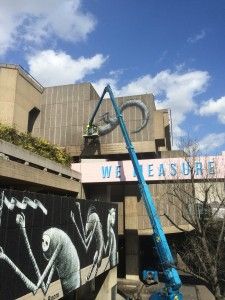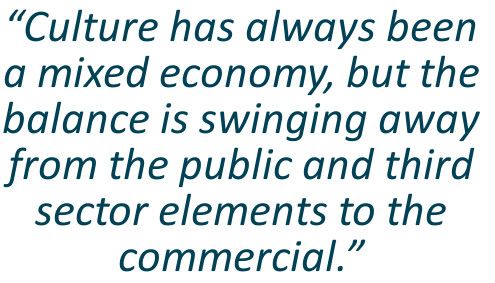Andrew Ormston is a long-standing expert on creative approaches to community regeneration. He is a Cultural Expert for the Education, Audiovisual and Culture Executive Agency of the European Union, and previous posts include Director of Culture at Birmingham City Council and Principal Theatres Officer at the City of Edinburgh Council. In this article, he reflects on successes and failures in attempts to deliver effective joint working across cultural, regeneration and planning sectors in the UK and Europe over the last 25 years. He also explains why, despite concerns about the growing commercialisation of cultural spaces, he is optimistic about the future.
I spent the early 1980s working in both social housing development and contemporary dance, unable to decide which was the most worthwhile career route.
Eventually, Local Government came to the rescue and roles as a county arts officer, and eventually a city culture director, meant there was a continuous stream of opportunities to connect up culture and regeneration, from market towns like Berwick-upon-Tweed, where an international film festival has taken root, to huge inner city schemes like Birmingham’s Eastside.
The Boom Years

Public art initiatives draw planners, artists and developers together
At any one time, there are always a number of drivers for culture and regeneration activity at play. Good old-fashioned civic pride is often present. Birmingham’s ‘gold standard’ Symphony Hall was a city centre catalyst of the Bilbao Guggenheim type, and an inspired expression of civic pride in a city’s musical traditions.
We tend to forget how important community leadership and action has been to the physical fabric and shape of areas like London’s South Bank or Covent Garden. Covent Garden Community Association and Coin Street Community Builders ensured that these jewels in London’s crown weren’t the late 20th Century equivalents of the current Nine Elms developments.
During the boom years in the 1990s, there were a number of aspirational public/private sector partnerships. Reading’s Oracle development with Hammerson included around £3m of public art, a community led art gallery, and a legacy of the award winning Art at the Centre programme that linked planners, artists and developers throughout the development process.
 There were even success stories for the often derided Percent for Art initiative, and I have been struck how current schemes like NHS Greater Glasgow & Clyde’s work with the arts is informed by practice developed through the use of ‘Percent’ in hospital developments over the years.
There were even success stories for the often derided Percent for Art initiative, and I have been struck how current schemes like NHS Greater Glasgow & Clyde’s work with the arts is informed by practice developed through the use of ‘Percent’ in hospital developments over the years.
Stalled Progress
Richard Florida’s creative city concept has also worked well as a kind of municipal shorthand for culture and regeneration, introducing the creative professions to the centre-ground of civic planning and development. Here was a narrative that was understood by a wide spectrum of interests, from politician and planner to artist and architect.
We have, however, failed to embed the learning and best methods of these decades into a discreet professional practice. Culture and regeneration, just like arts development, seems to have to constantly reinvent itself in new clothes. The Arts Council England Art at the Centre project is a good example. There were clear benefits around quality of design, public space, and community engagement in an approach that won awards and was documented by the Commission for Architecture and the Built Environment. But, two decades later, the idea of introducing artists to work alongside planners and developers still seems revolutionary.
Even where we can kindle enthusiasm for culture and regeneration, there is a question of whether we have reached a point where there just aren’t any clothes left that fit a process that requires a strong sense of community benefit and public good.
The Commercial Era

The rotunda to replace Glasgow’s Royal Concert Hall steps has been referred to as the ‘People’s Pedal Bin’
We now operate in a mutated development environment where we have creative cities in which artists can’t afford to live and work, and civic pride distorted into property price obsession. It is difficult to conceive of the bridges that can span our increasingly polarised society, particularly when regeneration and culture appear to be aligned with different poles.
Both culture and regeneration professionals work at a time when the interests of more and more people are simply being expelled from each sector. A malevolent cocktail of economic and social forces is at work, encapsulated at the global level by Saskia Sassen (see her recent book, Expulsions) and closer to home by Joyce McMillan in her recent Scotsman columns. Glasgow’s People’s Pedal Bin and Aberdeen’s Marischal Square are quoted as testament to a local democracy under threat from centralising and oligarchical power grabs.
Cultural institutions are far from immune as evidenced by high profile debates about the concentration of cultural investment in London and the commercialisation of public and cultural space. Culture has always been a mixed economy.
At present the balance is swinging away from the public and third sector elements to the commercial. This has both short term implications around public access to culture, and longer term ones around attitudes. Glasgow’s CitizenM hotel is now used to demonstrate the city’s cultural credentials as much as the concert hall or art school.
 The Future: Scotland in a Creative Europe
The Future: Scotland in a Creative Europe
Are there reasons to be optimistic? I think so.
Institutions and organisations seem to be waking up to the need for cross-sectoral working and more holistic purpose. We may not always pay enough attention to it, but we have an enormous body of evidence and learning at our disposal about linking culture with physical and social regeneration. The recently published Warwick Commission report on the Future of Cultural Value advocates a focus on the interface of the cultural and creative industries (which of course include architecture and design).

Creative Dundee is making an impact through public events like outdoor film screenings
Scotland’s growing interest in its European role is positive. The Council of Europe is currently discussing models that cross boundaries between cultural, social and economic impacts. The EU is welcoming SMEs into more and more investment routes, of particular importance in Scotland’s dispersed community of creative micro businesses and small SMEs.
Programmes like Creative Europe actively encourage collaborations across sectors and institutions. A number of UK cities are shaping up to bid to be European Capital of Culture, resulting in new impetus around culture and regeneration in each one. The place-making agenda is beginning to take a more concrete shape. For example, in England, the Creative People and Places programme is a culture and social regeneration initiative working across 21 areas where the arts audience demographic is most challenging.
What all of the approaches mentioned in this article needed to succeed was a spirit of collaboration and a partnership mechanism that reaches across the full culture and regeneration spectrum.
The success stories we read about are usually underpinned by these characteristics. Manchester assembles its assets into more than the sum of its parts. London’s South Bank Partnership introduces a level of shared responsibility and authority between local businesses, cultural organisations and communities. Creative Dundee is making impact and demonstrates a collegiate approach.
We should challenge anywhere that doesn’t have an effective cross-sectoral mechanism to support collaboration around culture and regeneration.
